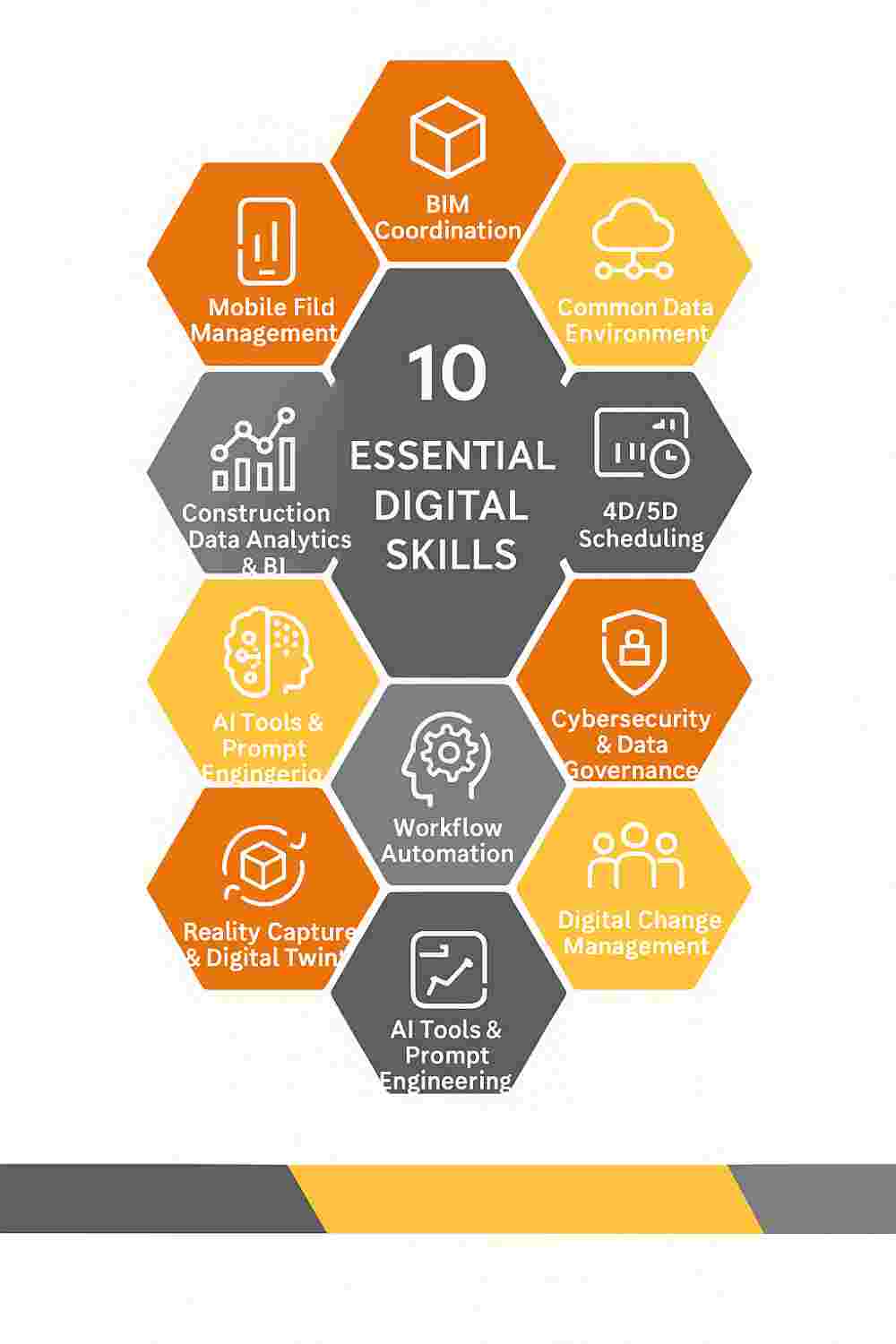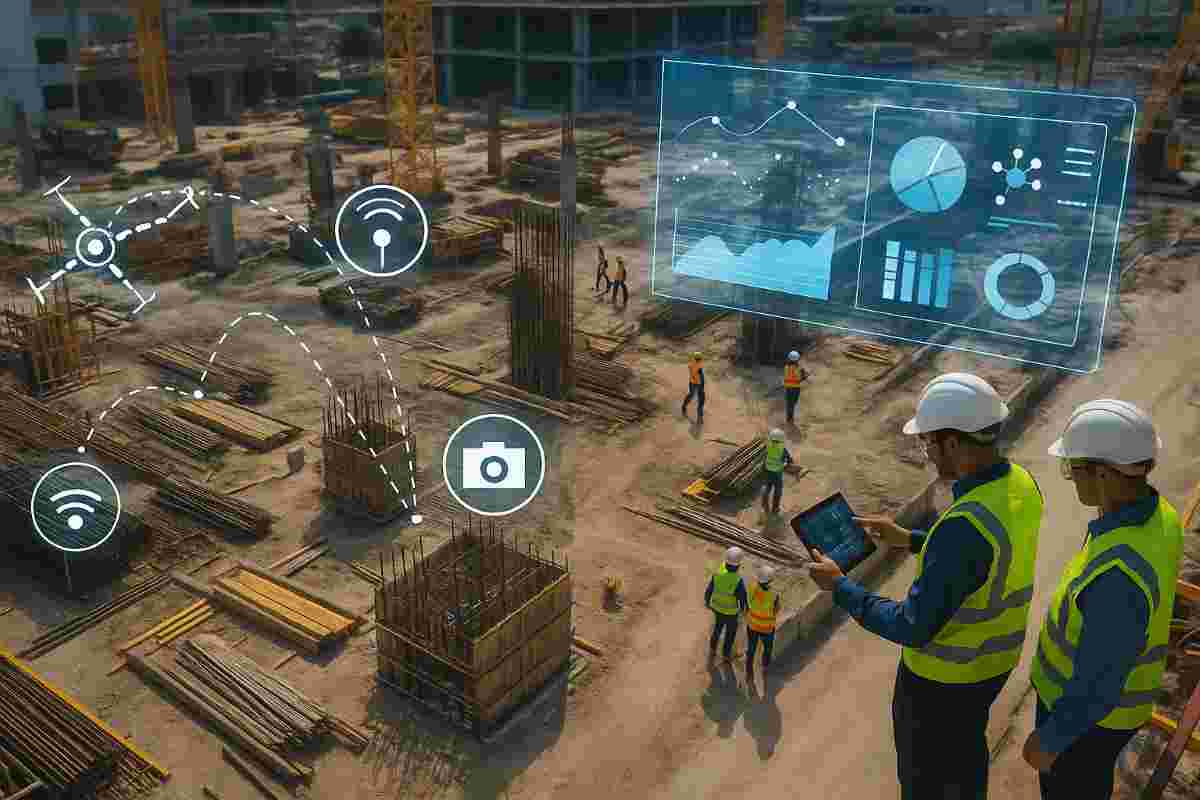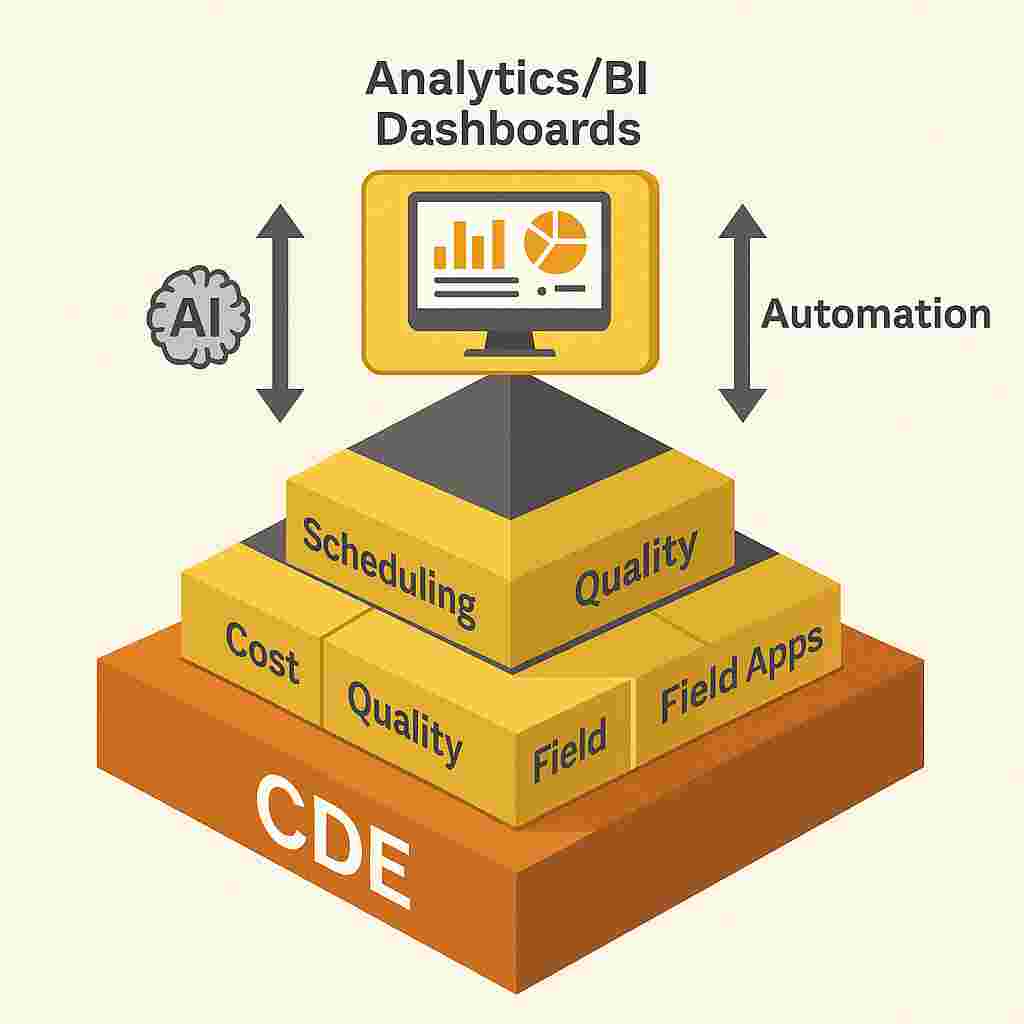Last Updated on September 23, 2025 by Admin
The industry’s digital shift is no longer optional. After decades of stalled productivity, leading analysts warn that construction must climb out of its productivity rut and modernize how projects are delivered. For project managers, that means digital skills are now the differentiator between teams that merely cope and those that consistently deliver.
Evidence is piling up that the payoff is real. In Autodesk’s global 2025 State of Design & Make, most leaders report a 50%+ return from digital transformation efforts, and digitally mature organizations are +30% more likely to report above-average or exceptional performance. Owners who build strong data foundations see outsized gains too: the Data-Centric Owner SmartMarket Report finds that 86% of highly data-centric owners experience project benefits such as more reliable cost and schedule estimates and improved quality and safety.
At the same time, AI literacy is rapidly becoming table stakes. PMI notes that AI fluency is non-negotiable for project professionals, with the vast majority believing AI will impact the profession—yet relatively few report strong hands-on experience today. And because data quality underpins every digital workflow, PMs should treat a Common Data Environment (CDE) aligned to ISO 19650 as the operational backbone for models, documents, and field data. :contentReference[oaicite:2]{index=2}
Practice 15+ AI-generated technical and HR interview questions for Civil, BIM, QS, Planning, HSE and Construction roles. Get instant feedback, improved answers, a 7-day improvement plan, and a full PDF report. Designed exclusively for construction professionals.
One free full interview session included. No credit card required.
This guide distills the 10 essential digital skills for construction project managers in 2025—from BIM/VDC and 4D/5D planning to analytics, mobile field management, cybersecurity, and AI—so you can prioritize the capabilities that move schedule, cost, quality, and safety in the right direction.
Table of Contents
1. BIM Coordination & Management
What It Is
Building Information Modeling coordination involves managing 3D models across disciplines to ensure constructability and detect conflicts before breaking ground.
Why It Matters for PMs
BIM pays off primarily by cutting rework. Peer-reviewed research finds that well-executed BIM can reduce rework by up to ~40% through earlier clash detection and design error elimination, and Dodge’s longstanding Business Value of BIM series has consistently ranked “reduced rework” among contractors’ top benefits.
For PMs, coordinated BIM workflows prevent costly field conflicts and speed decisions. When models drive coordination, teams report fewer document errors and faster communications—Autodesk’s industry analysis (summarizing multiple Dodge studies) notes that BIM processes materially reduce communication time, while Dodge highlights better cost and schedule performance as common outcomes of high-maturity BIM use.
Skipping BIM expertise raises commercial risk. Without robust model coordination, projects see more change-driven churn: empirical studies show change orders often add ~11–15% to total cost, with the AIA’s nationwide dataset placing the upper bound of typical cost growth from change orders at about 15%. Add to that the direct cost of rework—frequently measured around ~5% of project value—and the case for BIM-literate PMs becomes hard to ignore.
Core Tools & Standards
Master platforms include Autodesk Navisworks for clash detection, BIM 360 for model coordination, and Revit for understanding design intent. Familiarize yourself with ISO 19650 standards for BIM information management and LOD (Level of Development) specifications ranging from LOD 100-500.
Quick-Start Steps
- Complete Autodesk’s BIM Coordinator certification (40-hour online program)
- Practice weekly clash detection exercises using sample models
- Establish model coordination protocols with VDC teams
- Create standardized clash report templates for subcontractor meetings
KPIs/Metrics to Track
- Clashes resolved pre-construction vs. field-discovered issues
- Model update turnaround time
- RFI reduction percentage through model clarity
- Coordination meeting efficiency (issues resolved per hour)
Common Pitfalls & Fixes
Many PMs treat BIM as a designer’s tool rather than a project management asset. Fix this by embedding model reviews into weekly workflows. Another mistake: accepting models without verifying completeness. Solution: Implement model maturity matrices and require LOD verification before milestone approvals.
2025 Tip
Leverage AI-powered clash detection tools like AI tools for construction that automatically categorize and prioritize conflicts based on cost impact, reducing manual review time by 60%.
2. Common Data Environment (CDE) Administration
What It Is
A CDE provides a single source of truth for all project information, from contracts to models, accessible by authorized stakeholders.
Why It Matters for PMs
CDEs eliminate version control chaos that plagues 73% of construction projects (NBS National BIM Report 2024). PMs gain instant access to current documents, reduce information request delays by 80%, and maintain compliance with ISO 19650 requirements. Poor CDE management leads to an average of 13 hours weekly wasted searching for information.
Core Tools & Standards
Leading platforms include Autodesk Construction Cloud (ACC), Procore, and Aconex. Understand ISO 19650-2 for delivery phase information management and establish naming conventions following BS 1192 standards. Configure permission matrices aligned with project RACI charts.
Quick-Start Steps
- Map existing document workflows to CDE structure
- Define folder hierarchies matching work breakdown structures
- Establish automated approval workflows for critical documents
- Train teams on search operators and metadata tagging
KPIs/Metrics to Track
- Average document retrieval time (target: under 30 seconds)
- Version control incidents per month
- User adoption rate across stakeholders
- Compliance score for naming conventions
Common Pitfalls & Fixes
Teams often migrate to CDEs without standardizing processes first. Fix: develop comprehensive information management plans before platform deployment. Another issue: allowing email-based document sharing to continue. Solution: enforce “CDE-only” policies with automated email warnings for non-compliance.
2025 Tip
Implement AI document classification that auto-tags uploads based on content analysis, improving searchability by 85% without manual intervention.

3. 4D/5D Scheduling & Visual Planning
What It Is
4D scheduling links 3D models with time, while 5D adds cost data, creating visual simulations of construction sequences.
Why It Matters for PMs
Visual scheduling improves sequence understanding by 67% among field teams (Autodesk University 2024). PMs identify logistics conflicts, optimize crane positions, and communicate complex phasing to non-technical stakeholders. Projects using 4D/5D scheduling report 28% fewer delays and 19% better resource utilization.
Core Tools & Standards
Utilize Synchro PRO for comprehensive 4D/5D modeling, Navisworks TimeLiner for basic sequencing, and integrate with Primavera P6 or Microsoft Project schedules. Apply lean construction principles including Last Planner System pull planning and takt time optimization.
Quick-Start Steps
- Link existing schedules to 3D model components
- Create site logistics animations for major phases
- Develop visual look-ahead schedules for weekly meetings
KPIs/Metrics to Track
- Schedule variance (planned vs. actual) improvement
- Spatial conflict identification rate
- Subcontractor schedule buy-in scores
- Equipment utilization optimization percentage
Common Pitfalls & Fixes
Creating overly detailed 4D models that become maintenance burdens. Fix: focus on critical path and high-risk sequences only. Another mistake: not updating models after schedule changes. Solution: establish bi-weekly model synchronization protocols.
2025 Tip
Combine 4D models with IoT sensor data from equipment to create real-time progress overlays, enabling predictive schedule adjustments.
4. Construction Data Analytics & BI
What It Is
Transforming project data into actionable insights through visualization, pattern recognition, and predictive modeling.
Why It Matters for PMs
Data-driven PMs make decisions 5x faster and with 23% better accuracy (PMI Pulse of the Profession 2024). Analytics reveals hidden cost drivers, predicts delays before they occur, and quantifies risk impacts. Without analytics capabilities, PMs miss 40% of early warning signals for project issues.
Core Tools & Standards
Master Power BI for dashboard creation, Excel Power Query for data transformation, and basic SQL for database queries. Understand earned value management (EVM) metrics and integrate with cost estimation software like ProEst or STACK. Learn Python basics for custom analysis when needed.
Quick-Start Steps
- Build standardized project dashboards tracking cost, schedule, safety, and quality
- Automate daily progress reports pulling from multiple systems
- Create predictive models for common risk factors
- Establish data quality checks for source systems
KPIs/Metrics to Track
- Report generation time reduction (manual vs. automated)
- Forecast accuracy improvement percentage
- Data-driven decisions per week
- Cost variance prediction accuracy
Common Pitfalls & Fixes
Creating vanity metrics that don’t drive action. Fix: align every metric with specific decision points. Another issue: data silos preventing comprehensive analysis. Solution: implement API integrations between platforms using tools like Zapier or custom Power Automate flows.
2025 Tip
Deploy machine learning models that analyze historical project data to predict resource needs, reducing idle time by up to 35%.
5. Mobile Field Management & Digital QA/QC
What It Is
Managing construction operations through mobile apps that enable real-time data capture, issue tracking, and quality control from the field.
Why It Matters for PMs
Mobile workflows reduce paperwork by 90% and accelerate issue resolution by 4.5 days average (Procore’s 2024 Construction Technology Report). PMs gain immediate visibility into field conditions, eliminate data entry delays, and improve safety compliance documentation. Projects with digital QA/QC systems experience 56% fewer defects at turnover.
Core Tools & Standards
Deploy platforms like PlanGrid for drawing management, Fieldwire for task coordination, and Procore Quality & Safety modules. Implement digital checklists following OSHA standards and customize forms for specific trade inspections. Utilize Bluebeam Revu for mobile markups and punch list management.
Quick-Start Steps
- Digitize top 20 most-used paper forms
- Train superintendents on photo documentation standards
- Configure automatic issue routing based on severity
- Establish offline sync protocols for connectivity issues
KPIs/Metrics to Track
- Issue close-out time (creation to resolution)
- Inspection completion rates
- Photo documentation per work package
- First-time quality pass percentage
Common Pitfalls & Fixes
Overwhelming field teams with too many apps. Fix: consolidate to maximum three core platforms. Another mistake: poor connectivity planning. Solution: invest in mobile hotspots and ensure apps function offline with proper sync capabilities.
2025 Tip
Implement AR-enabled inspections using HoloLens or iPad Pro, overlaying BIM models on actual construction for immediate deviation detection.

6. AI Tools & Prompt Engineering
What It Is
Leveraging artificial intelligence for document generation, decision support, and process automation through effective prompt design.
Why It Matters for PMs
AI reduces administrative tasks by 40%, freeing PMs for strategic work (McKinsey 2024). Digital skills for construction project managers now include AI literacy as firms adopt copilots for RFI responses, meeting minutes, and risk analysis. PMs proficient in prompt engineering complete documentation 3x faster with higher quality.
Core Tools & Standards
Master ChatGPT for content generation, Microsoft Copilot for Office integration, and specialized tools like ALICE for AI-powered scheduling optimization. Understand prompt engineering principles: context setting, constraint definition, and output formatting. Learn responsible AI practices including bias detection and output verification.
Quick-Start Steps
- Create prompt library for common PM tasks (RFIs, safety reports, emails)
- Establish AI output review protocols
- Train teams on effective prompt construction
- Document successful use cases for knowledge sharing
KPIs/Metrics to Track
- Document creation time savings
- AI-assisted vs. manual task completion rates
- Quality scores for AI-generated content
- Team AI tool adoption percentage
Common Pitfalls & Fixes
Over-relying on AI without verification. Fix: implement mandatory human review for critical documents. Another issue: generic prompts producing poor results. Solution: develop role-specific prompt templates with construction context and terminology.
2025 Tip
Use AI agents that continuously monitor project communications, automatically flagging risks and suggesting mitigation strategies based on pattern recognition.
7. Reality Capture & Digital Twins
What It Is
Creating accurate digital replicas of physical construction through drone photogrammetry, LiDAR scanning, and continuous sensor monitoring.
Why It Matters for PMs
Reality capture reduces measurement errors by 95% and enables remote inspections saving 8 hours weekly (DroneDeploy 2024 Report). Digital twins provide real-time project status, automate progress tracking, and enable predictive maintenance post-construction. Projects using reality capture report 41% fewer RFIs and 62% faster as-built documentation.
Core Tools & Standards
Utilize DroneDeploy or Pix4D for aerial mapping, Matterport for interior scanning, and Faro or Leica scanners for precision LiDAR. Understand photogrammetry principles, point cloud processing, and mesh generation. Integrate with platforms like Bentley iTwin for digital twin creation.
Quick-Start Steps
- Establish weekly drone flight schedules for progress monitoring
- Create scan-to-BIM workflows for deviation analysis
- Deploy IoT sensors for continuous structural monitoring
KPIs/Metrics to Track
- Progress tracking accuracy (automated vs. manual)
- Rework identification speed
- As-built documentation time reduction
- Virtual inspection frequency
Common Pitfalls & Fixes
Capturing data without clear purpose. Fix: define specific use cases before each capture mission. Another mistake: inadequate data management causing storage bloat. Solution: establish retention policies and compression standards.
2025 Tip
Combine computer vision AI with reality capture to automatically quantify installed quantities, generating payment applications with 98% accuracy.

8. Workflow Automation & API Integration
What It Is
Connecting disparate construction systems through APIs and creating automated workflows that eliminate manual data transfer.
Why It Matters for PMs
Automation saves 15 hours weekly on repetitive tasks (Zapier’s 2024 Automation Report). PMs who master integration reduce data entry errors by 87%, accelerate information flow between stakeholders, and ensure real-time synchronization across platforms. Manual processes cause 34% of project delays due to information lag.
Core Tools & Standards
Learn Zapier for no-code automation, Microsoft Power Automate for enterprise workflows, and basic API concepts (REST, webhooks, authentication). Understand JSON data structures and implement error handling protocols. Connect systems like Procore-to-ERP, BIM 360-to-Power BI, and email-to-task management.
Quick-Start Steps
- Map current manual data transfers between systems
- Prioritize high-frequency, high-value workflows for automation
- Build test automations with error notifications
- Document automation logic for maintenance
KPIs/Metrics to Track
- Manual process elimination percentage
- Data synchronization lag time
- Error rates pre/post automation
- Cost savings from reduced administrative hours
Common Pitfalls & Fixes
Creating brittle automations that break with minor changes. Fix: build error handling and notifications into every workflow. Another issue: automation sprawl without governance. Solution: maintain automation registry with ownership and review schedules.
2025 Tip
Deploy RPA (Robotic Process Automation) bots that handle complex multi-system workflows, like automated change order processing from field report to accounting approval.
9. Cybersecurity & Data Governance
What It Is
Protecting project data, ensuring compliance with regulations, and maintaining information integrity across digital platforms.
Why It Matters for PMs
Construction cyberattacks increased 89% in 2024, with average breach costs reaching $4.8M (NIST Cybersecurity Framework Report). PMs manage sensitive data including financials, blueprints, and personnel information requiring protection. Strong data governance ensures compliance with GDPR, CCPA, and client requirements while preventing costly breaches.
Core Tools & Standards
Implement ISO 27001 information security standards and NIST Cybersecurity Framework. Understand multi-factor authentication, encryption protocols, and access control matrices. Master data classification systems and establish incident response procedures. Configure security settings in Procore, ACC, and other platforms.
Quick-Start Steps
- Conduct security audits of all project systems
- Implement role-based access controls aligned with project phases
- Establish data backup and recovery procedures
- Create security training programs for project teams
KPIs/Metrics to Track
- Security incident frequency and severity
- Compliance audit scores
- Data access audit completion rates
- Security training completion percentage
Common Pitfalls & Fixes
Treating security as IT’s sole responsibility. Fix: embed security considerations into PM workflows and decision matrices. Another mistake: weak password policies. Solution: enforce password managers and mandatory MFA for all project systems.
2025 Tip
Implement zero-trust architecture with continuous verification, reducing breach risks by 76% compared to perimeter-based security.
10. Digital Change Management & Stakeholder Communication
What It Is
Leading technology adoption across diverse teams while maintaining clear digital communication channels with all stakeholders.
Why It Matters for PMs
70% of construction technology implementations fail due to poor change management (Prosci 2024). PMs who excel at digital transformation achieve 3x higher adoption rates and 45% faster ROI realization. Effective stakeholder communication through digital channels reduces misunderstandings by 58% and accelerates decision-making by 4 days average.
Core Tools & Standards
Master collaboration platforms like Microsoft Teams or Slack for team communication. Utilize Miro or Mural for virtual workshops and stakeholder mapping. Implement change management frameworks like ADKAR or Kotter’s 8-Step Process. Configure automated stakeholder reporting through BIM basics and project dashboards.
Quick-Start Steps
- Develop digital adoption roadmaps with clear milestones
- Create role-specific training programs for new tools
- Establish digital communication protocols and response time expectations
- Build change champion networks across trades
KPIs/Metrics to Track
- Technology adoption rates by user group
- Digital tool utilization percentages
- Stakeholder satisfaction scores
- Communication response time averages
Common Pitfalls & Fixes
Forcing technology without addressing cultural resistance. Fix: involve end-users in tool selection and customization. Another issue: information overload through too many channels. Solution: Establish single sources of truth and clear escalation paths.
2025 Tip
Use sentiment analysis AI on project communications to identify adoption barriers and team morale issues before they impact productivity.
Conclusion: Your Digital Transformation Roadmap
Mastering these construction PM skills 2025 positions you at the forefront of industry transformation. Start with one skill area, achieve proficiency, then expand systematically. The digital transformation in construction rewards early adopters with competitive advantages that compound over time.

Construction firms report that PMs with comprehensive digital skills command 25-40% higher salaries and receive 3x more project leadership opportunities. Your investment in these capabilities pays dividends through enhanced project outcomes, team efficiency, and career advancement.
“The best time to develop digital skills was five years ago. The second-best time is now.”
Related Posts:
- The Silent Career Killers in Construction – And How to Avoid Them
- The 6 Essential Project Management Skills Every PM Needs
- Construction Technology and Management: Complete Career Guide 2025: Courses, Skills & Salary Trends
- What are the 8 Top Skills to Become an ESG Certificate Holder?


